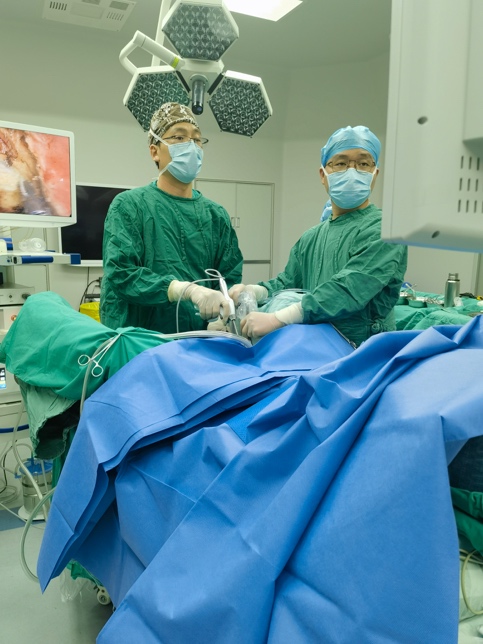Mr. Su came from Hunan province. He had been experiencing symptoms of ankylosing spondylitis since he was 20 years old. However, for various reasons, he did not receive proper treatment. As the disease progressed, he had thoracic and lumbar spine deformities, his sacroiliac joint function became abnormal, and could not even lie flat at night.
Three months ago, Mr. Su experienced sudden hematochezia. Persistent symptoms made him anxious, so he went to the local hospital for a colonoscopy. A 2*3 cm tumour was found 10 cm away from the anal verge. Pathological biopsy finally confirmed (rectal) moderately differentiated adenocarcinoma.
To receive better diagnosis and treatment, Mr. Su sought medical attention at a Grade III public hospital (top grade) in Changsha. After further examination, it was considered upper rectal cancer, and medical staff surgery should be performed.
Before starting anaesthesia, the surgical team reassessed whether the operation could be performed. Because Mr. Su had a forward curvature of the spine (kyphosis), the upper and lower abdomen were completely attached together. There was no space for conventional laparoscopic surgery.
After repeated consideration, the surgical team decided to suspend the surgery to avoid unnecessary trauma and to avoid increasing the difficulty of future surgeries.
Later, Mr. Su learned that Dr. Kang Liang and his team from the Colorectal Surgery Department of the Sixth Affiliated Hospital of Sun Yat-sen University can perform transanal surgery for rectal cancer.

(Photo provided to GDToday)
Regarding Mr. Su's condition, the surgical position, methods, potential difficulties during the operation, and an emergency plan were discussed via an MDT approach. Combining the patient's current situation, Dr. Kang Liang’s team ultimately formulated a treatment plan.
The team used a transanal endoscopic technique to resect the rectal tumour from bottom to top. After it was completely freed through the anus, the intestinal tube was separated through a small abdominal incision, and then the primary anastomosis was performed through the anus. The operation went smoothly.
Because it is minimally invasive, Mr. Su was able to get out of bed and start a clear liquid diet under the care of his family on the first day after the surgery. Eventually, pathological results showed that the tumour had been completely removed. He recovered well and was discharged from the hospital five days after the operation.
Dr. Kang Liang also noted that the transanal endoscopic technique has not only advantages in difficult radical surgery for rectal cancer, but also unexpected benefits in dealing with other rectal diseases with obesity, abdominal deformities, and “difficult pelvis”.
Author | Hannah, Li Fuying (intern)
Editor | Wing, Steven, Abby, James
















